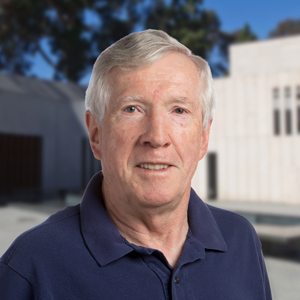Source: Interfolio F180

Peter Wright, PhD
Research Focus
Structure, Dynamics and Interactions of Proteins.
My laboratory utilizes high-resolution nuclear magnetic resonance (NMR) spectroscopy and other biophysical and biochemical methods to investigate the structure, dynamics, and folding mechanisms of proteins and to map their functional interactions. NMR is unique as a method for determining three-dimensional structures of proteins and protein complexes in solution and also providing novel information about the time-dependent structural fluctuations that are essential for protein function.
Intrinsically disordered proteins and cellular signaling. Intrinsically disordered proteins are highly abundant in eukaryotes and play a central role in cellular regulatory processes and signaling pathways. We are using a multidisciplinary approach, including a broad range of biochemical and biophysical methods, NMR, and single molecule fluorescence (in collaboration with Ashok Deniz), to elucidate the structure of the general transcriptional coactivators CBP and p300 and characterize their functional interactions with key cellular and viral targets. We are implementing novel NMR methods, intein labeling technologies, and single molecule FRET methods to characterize the structure and dynamics of disordered proteins and their complexes and to elucidate the mechanism by which disordered proteins fold upon binding to their targets.
Mechanisms of protein folding and misfolding. NMR is uniquely suited for studies of protein folding and misfolding pathways, providing detailed insights into the structure and dynamics of unfolded states and partially folded intermediates. We are applying NMR relaxation dispersion methods and real-time 19F NMR to elucidate the molecular mechanism by which the protein transthyretin spontaneously unfolds and aggregates, leading to amyloid disease.
Protein dynamics and "invisible" excited states. We are applying NMR relaxation dispersion methods to characterize the dynamics of the enzyme dihydrofolate reductase and to determine the structure of weakly populated excited states that play a functional role in catalysis. These studies, which are also being applied to study the dynamics of a stress-activated protein kinase, are providing unprecedented insights into the intrinsic dynamics of enzymes and their role in catalysis.
Education
M.S. (Chemistry), University of Auckland, 1969B.S. (Chemistry), University of Auckland, 1968
Ph.D. (Chemistry), University of Auckland, 1972
Professional Experience
2013-Present Professor, TSRI1987-2012 Chair, TSRI
1984-1986 Professor, TSRI
1976-1984 Lecturer/Senior Lecturer, University of Sydney
1972-1976 Postdoctoral Fellow, University of Oxford
Awards & Professional Activities
1969 New Zealand University Grants Committee Post-Graduate Scholar1972 New Zealand University Grants Committee Postdoctoral Fellow, University of Oxford
1987 Endowed Chair, Cecil H. and Ida M. Green Investigator in Medical Research
1994 NIH Merit Award, National Institutes of Health
1995 Honorary Doctor of Medicine, Karolinska Institute, Stockholm
1995 Elected to the American Academy of Arts and Sciences
1998 Fellow, American Association for the Advancement of Science
2003 Honorary Doctor of Science, The University of Sydney
2006 Honorary Member, NMR Society of Japan; 2008 Leach Medal
2008 Member, The National Academy of Sciences
2008 Fellow, International Society of Magnetic Resonance (ISMAR)
2009 Honorary Member, Israel Chemical Society
2010 The Stein and Moore Award, The Protein Society
2010 Distinguished Scientist Award, San Diego Chapter, American Chemical Society
2019 ISMAR Prize, International Society of Magnetic Resonance
2019 Akutsu Award, Korean Magnetic Resonance Society
Selected Publications
Boehr, David D.; McElheny, Dan; Dyson, H. Jane; Wright, Peter E. The Dynamic Energy Landscape of Dihydrofolate Reductase Catalysis. Science 2006, 313, 1638-1642.
[View]
Sugase, K.; Dyson, H. J.; Wright, Peter E. Mechanism of coupled folding and binding of an intrinsically disordered protein. Nature 2007, 447, 1021-1025.
[View]
Ferreon, Allan C.; Ferreon, Josephine C.; Wright, P E.; Deniz, Ashok A A. Modulation of allostery by protein intrinsic disorder. 2013, 498, 390-4.
Berlow, R. B.; Dyson, H. J.; Wright, Peter E. Hypersensitive termination of the hypoxic response by a disordered protein switch. Nature 2017, 543, 447-451.
[View]
Sun, Xun; Dyson, H. Jane; Wright, Peter E. Kinetic analysis of the multistep aggregation pathway of human transthyretin. Proceedings of the National Academy of Sciences 2018, 115, 10040-10045.
[View]
Krois, Alexander S.; Dyson, H. J.; Wright, Peter E. Long-range regulation of p53 DNA binding by its intrinsically disordered N-terminal transactivation domain. Proceedings of the National Academy of Sciences of the United States of America 2018, 115, E11302-E11310.
[View]

